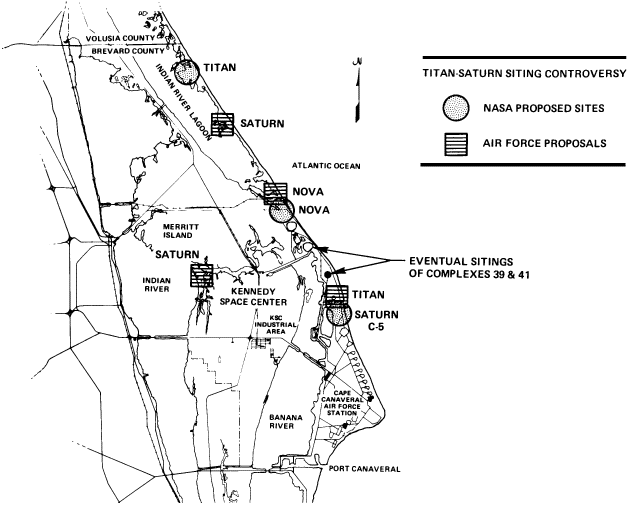
The Titan III Problem
During the fall of 1961, the Air Force was faced with the problem of finding a launch area for its new Titan III. This 39-meter missile consisted of a liquid-fueled central rocket flanked by two solid boosters of great power. Launch sites on Cape Canaveral, including pad 18, pad 20, and the tip of the Cape, were deemed unusable on account of blast and toxicity factors. Events took a collision course when Missile Test Center administrators decided the new NASA land on Merritt Island could be considered as a possible Titan launch site. The Air Force would place the Titan complex just north of complex 37, spacing the pads for use of class IX* explosives. On the premise that the Air Force had master planning powers over the entire launch area, including the land NASA was acquiring on Merritt Island, the recommendation to site Titan III north of complex 37 and partly on NASA land (and submerged land) was accepted by Air Force Headquarters and approved by the Department of Defense. Further, a Titan overflight of LC-37 appeared to be no problem, and the corrosive effects of the Titan rocket exhaust would be negligible. The Missile Test Center proposed that NASA move its launch pads north to accommodate Titan III.48

The Titan-Saturn siting controversy.
To this, Debus could not agree. LOD believed the corrosive effects of the Titan exhaust would pose a serious hazard to NASA space vehicles on launch complexes 34 and 37, and that any overflight would create serious safety restrictions. Placing the Titan III integration building on Merritt Island would interfere with NASA's canal and bridge plans. The proposed Titan III firing rate would close down launch complex 37 or pad A of launch complex 39 once every ten days. Moving LC-39 farther north would double the distance from assembly building to launch area, increase the cost of communications lines by $1 million, and force NASA personnel to detour around the Titan III area in going from the Cape to LC-39. In sum, LOD believed a Titan III failure could seriously endanger NASA's flight hardware, pads, and personnel; that Titan launch operations would interfere with NASA activities; and that a heavy concentration of escaping propellants from Titan III might cause serious corrosion problems in NASA spacecraft. Finally, LOD did not intend to launch spacecraft over Air Force sites and did not want Air Force missiles flying over its pads. The Launch Operations Directorate concluded that Titan III should be located north of the NASA area and recommended the purchase of an additional 60 square kilometers of land above the Haulover Canal for that purpose.49
The Air Force was agreeable to buying this land and earmarking it for NASA, but this was no balm to LOD. The Titan affair seemed to say, if not in so many words, that the Air Force was standing on its rights as master of the entire launch area and deemed Merritt Island an extension of the Cape. Debus and his staff were troubled about the implications of the situation and tried - for many weeks without success - to convey their concern to the NASA administration.
In an effort to work out some of the problems, General Shriever, General Davis, and their staffs met on 19 February 1962 with a NASA team of D. Brainerd Holmes, Debus, and others. The conference produced a lamentable communications gap. Shriever understood that Holmes and Debus were agreeable to siting Titan III in the south where the Air Force wanted it, deferring selection of a moonport site, and purchasing additional land north of Haulover Canal. The actual NASA position, as set out at a Management Council meeting under Holmes's chairmanship on 27 February, was that "the preferable solution to Cape siting problems is immediate acquisition of additional land to the north and siting the Titan III at the north, Nova in the center, and [Saturn] C-5 to the south."50 Much of the following month was devoted to the solution of this impasse, a process complicated by misunderstandings within the NASA command. Much to Debus's disappointment, NASA agreed tentatively to the southern sitings.51 On 27 March a statement of the acceptability of overflight was signed by L. L. Kavanaugh, for the Department of Defense, and Robert Seamans. A still unreconciled Debus told the Management Council that NASA should retain control over NASA-purchased lands and seek an amendment to the Webb-Gilpatric Agreement providing for joint master planning.52
* In the U.S. military forces, this designation identifies high explosives such as dynamite, materials that are very susceptible to ignition by spark or friction and burn with explosive violence.
| Next |